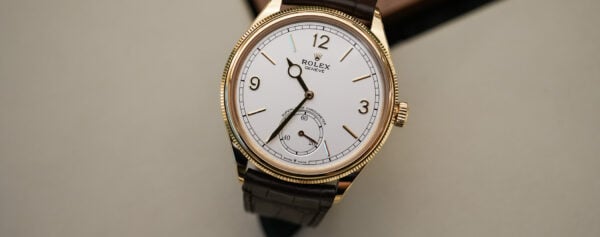The Audemars Piguet Universelle RD#4, with 40 functions, including 23 complications and 17 technical devices, is the fourth in its series of Research and Development watches, building and elaborating on innovations from the first three. The series reasserts Audemars Piguet’s status as one Switzerland’s most important heritage watchmakers (one of the so-called holy trinity, along with Patek Philippe and Vacheron Constantin). It reminds us that there is—and always has been—more to Audemars Piguet than the Royal Oak, just as there is more to Patek Philippe than the Nautilus. As if to reinforce that, the RD#4 is debuting in the Code 11.59 collection, whereas the first three were all Royal Oaks. Given that RD#4 was inspired by an Audemars Piguet pocket watch made in 1899. With 26 functions, including 19 complications, it is a serious supercomplication.

Introducing the RD#4 in the Code 11.59 line is a shrewd juxtaposition that links Audemars Piguet’s heritage as a producer of ultra-complications with its most recent collection, almost a century later. It aggregates the innovations from AP’s first three RD pieces, including the Supersonnerie technology unveiled in RD#1 (2015), the ultra-thin perpetual calendar movement launched in RD#2 (2018) and the oscillator with increased amplitude premiered on the two Royal Oak Selfwinding Flying Tourbillon Extra-Thin RD#3 models (2022).
The movement, automatic caliber 1000, was seven years in development and comprises over 1,100 components. The 23 complications include all the big ones: grande sonnerie supersonnerie, petite sonnerie, minute repeater, perpetual calendar, split-seconds flyback chronograph, flying tourbillon and moon phase. The 17 technical devices refer to mechanisms incorporated into the movement that optimize functions, including a dedicated swivel clutch on the chronograph to avoid stutter on the seconds hand when activated, a silent strike-speed regulator on the chiming mechanism and the forward/backward fast date corrector on the 3 o’clock crown.

Given its multitude of functions and components, the RD#4 should be the size of a hockey puck, and it might have been had it been made a century ago. Thus, its most important feat is arguably one of micro-engineering: it fits into a case measuring only 42mm x 15.55mm. Audemars Piguet technical director and well-known watchmaker Giulio Papi says the goal was to make it wearable. “This ultra-complication is the culmination of several decades of research, design and manufacturing of many different types of complicated mechanisms that have put ergonomics at the forefront of the process,” he says. “We believe that a mechanical function with an ergonomic focus opens a new path for Audemars Piguet and the watch industry as a whole.”

Another of its great features is the simplification of the pushers and correctors, narrowed down to three crowns on the right and three discreet pushers on the left, that are almost flush with the case. The three crowns wind the watch, set the time and date with the central crown and select the chiming mode (grande sonnerie, petite sonnerie or silence mode). The top pusher starts the minute repeater function, and the two lower ones correct the moon and day indications. The flyback chronograph can be started and stopped with what Audemars Piguet calls the “supercrown” at 2 o’clock, and then reset with the other “supercrown” at 4 o’clock, which also corrects the month in sync with the year, in either forward or backward modes.

The chiming function includes the patented Supersonnerie technology, introduced in 2015, which, instead of attaching the gongs to the mainplate, attaches them to a component acting as a soundboard that improves sound transmission. The mechanism is optimized in the RD#4 by placing it in a dedicated double caseback system with a “secret” extra-thin cover and a new soundboard, just 0.6 mm thick, made of sapphire crystal, on which the gongs are mounted. It took three years just to develop a water-resistant sapphire component with the right geometry and thickness to act as a soundboard. The double caseback system brings the mechanism into view, whereas before it was hidden on the caseback side by the technology’s resonance chamber. To optimize energy management and distribution, the chiming functions are fed by a dedicated barrel.

The perpetual calendar builds on the patented innovations of caliber 5133 in the Royal Oak Selfwinding Perpetual Calendar Ultra-Thin RD#2 prototype, which merges the perpetual calendar functions onto a single level. It displays the day and month at 9 and 3 o’clock—in subdials or windows (depending on the model) that are slightly elevated in order to give space to the tourbillon carriage at 6 o’clock. The date is shown in a window at 12 o’clock, and instead of including a leap year indicator, it shows the year in a small window at 4:30. This one is a semi-Gregorian perpetual calendar, which, unlike the Gregorian calendar, will need manual correction every 400 years instead of every 100. It will not need to be reset until 2400.

A larger mainspring barrel was developed to power the hands, chronograph and calendar functions, while the chiming complications are fed by a dedicated barrel. This more powerful mechanism, introduced on the RD#3 Royal Oak Selfwinding Flying Tourbillon Extra-Thin, gives the watch some 60 hours of power reserve.
Each of the four references—two skeletonized versions and two with dials—are unique pieces (which, of course, means price upon request). But there are three more that are reserved for VVIPs to customize through special order.




